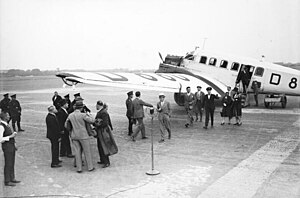Junkers G 24
| G 24 | |
|---|---|
 |
|
| Junkers G 24 in 1930 | |
| Role | Airliner-Transport |
| Manufacturer | Junkers |
| First flight | 19 September 1924 |
| Introduction | 1925 |
| Primary users |
Deutsche Luft Hansa Luftwaffe |
| Produced | 1925-1929 (German production) 1924- (Sweden) |
| Number built | Germany: ~72 Sweden: 20 + 23 K 30s |
The Junkers G 24 was a German three-engine, all-metal low-wing monoplane passenger aircraft manufactured by Junkers from 1925. Junkers F 24 was the designation for single-engine versions of the same aircraft.
The increased German air traffic in the 1920s led to a requirement for a larger passenger transport aircraft. The G 24 was an enlarged development of the F 13. It was originally designed by Ernst Zindel as a single-engine aircraft. Under the restrictions imposed on aircraft in Germany by the Treaty of Versailles, only low powered engines were allowed. So the Junkers company designed their large G24 airliner to be single-engined, but built it as a tri-motor. With three low powered engines the G24 could fly, but was not a viable airliner. The plan was to sell the tri-motors to airlines outside of Germany, who would then install a single, high-powered engine (e.g. 450 hp Napier Lion) on the nose, and simply remove the wing center-section plugs that carried the other two engines. However the Military Inter-Allied Commission of Control declared the G24 design to be a military type aircraft, and outlawed it.
Junkers then resubmitted what was essentially the same design, but under a new designation: Junkers G23. The Allied Commission ultimately allowed Junkers to build the G23, even in the single engined version, because it was clearly an airline type. The plane was always marketed under the G24 designation. (This paragraph based on 'Wagner' pages 230 - 234)
Junkers continued to build the G24/G23 as a tri-motor, because the ruse to circumvent the Allied restrictions also had the benefit that the plane could fly, and even climb, with one engine out. In 1925 most airliners were single-engined, since one big engine will usually be more efficient than several small ones. Twin-engine types could not maintain altitude with an engine out, unless they were so overpowered that the airlines could not afford to operate them. A tri-motor did not have to be so grossly overpowered, to be able to fly with an engine out.
On May 1, 1926 newly formed German airline Deutsche Luft Hansa started flying passengers on the route Berlin - Königsberg at night using G24 aircraft ('Wagner' page 232 'Seifert' page 376). This was the first time any airline, anywhere in the world, flew passengers at night. Previously airlines had flown only mail and freight after dark. If an engine failed, the pilot bailed out by parachute, since a forced landing in the dark is too dangerous. The Junkers G24 could carry passengers, since there would not be any forced landings. The G24s of Luft Hansa also had blind flying instruments and radio navigation (with the radio operator sitting in the passenger cabin, as there was no room in the open two seat cockpit).
...
Wikipedia
